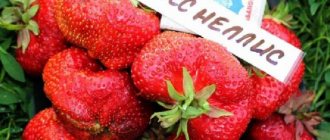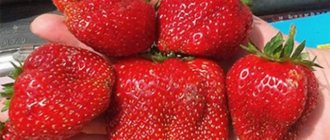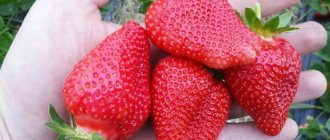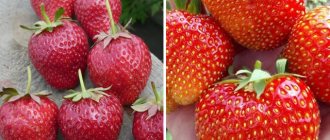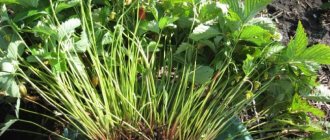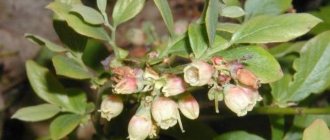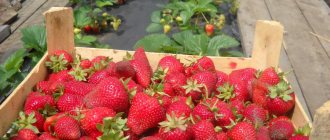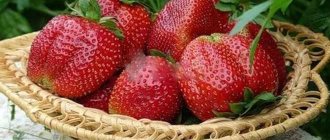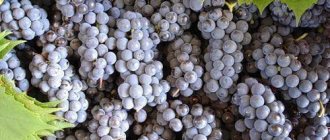Vima Tarda strawberry is a mid-late, non-repairing variety of garden strawberry, bred by the famous Dutch company Vissers Aardbeiplanten BV. To create this variety, a variety from the “Vima” line was used - Vima Xima. It was crossed with the fairly popular Vikoda variety.
It entered the State Register of the Russian Federation only in 2021; in Belarus it was accepted into the State Register in 2006.
Vima Tarda is recommended to be grown in the Central region of our country.
In today's publication you will learn a detailed description of the variety, see photos of Vima Tarda's berries, and also read reviews from gardeners who managed to grow this amazing Dutch strawberry on their plot.
Description of the strawberry variety VimaTarda
The Vima series is characterized by large bushes, dense lush foliage and strong growth of stems. Tarda is no exception. The plant forms a powerful bush with a large number of peduncles. The bush is spreading, densely leafy.
Strawberry leaves are dark green in color, very large in size, and shiny. The plates are ribbed and concave, slightly wrinkled and pubescent. The main leaf area is rounded, the base is sharp. The stipules are wide, short, and pink.
The flowers of the variety are bisexual, beautiful white, and quite large. The inflorescences are spreading, located on thick powerful peduncles and located at a level below the leaves.
The whiskers are also large and powerful, but the whisker formation of the Tarda variety is average. The color of the aerial shoots is pale red.
The fruits are held suspended by strong legs without touching the ground.
The berries are the pride of the strawberry variety. They are large, orange or dark red in color. The weight of one strawberry reaches 60 g with a good agricultural background. The shape of the fruit is cone-shaped. Some specimens are shaped like a fan or comb. The first berries weigh the heaviest (up to 45 g), the second wave produces slightly smaller specimens (about 35 g). The skin is glossy with uneven coloring and yellow seeds, slightly pressed into the pulp. According to the description of the strawberry variety Wima Tarda, the pulp of the fruit has a dense consistency. It is aromatic and juicy, contains a large amount of useful substances. Tasting score 4.3-4.5 points out of 5. The taste is sweet with a very slight hint of acid. The aroma is persistent and pleasant, reminiscent of wild strawberries. Ripe berries are covered with leaves, which makes the harvesting process longer. But this feature saves the fruits from the scorching sun.
Reviews
Many gardeners have positive reviews of the Wima Tarda strawberry variety, and we will now see this using several examples.
Vima Tarda is a mid-late, non-repairing variety of garden strawberries (strawberries) for dessert purposes. Bred in the Netherlands by specialists from Vissers Aardbeiplanten BV. Belongs to the Vima family - a group of varieties of Dutch selection that have proven themselves very well both in production areas and in household plots. Among the most prominent representatives of this line are V. Xima, V. Rina, V. Kimberly, as well as V. Zanta, who is one of the parental forms of our heroine. The second “parent” was the popular Vikoda. Vima Tarda inherited the best characteristics from her ancestors, however, among the entire family, “Vima” is not yet the most famous. This strawberry clearly deserves more attention, as it has all the necessary qualities to please both the ordinary summer resident and the entrepreneurial farmer.
The plant is powerful, medium-sized, abundantly leafy. The formation is scanty. The leaves are large, wide, dark green in color with a glossy sheen. Flowers bisexual, white. The peduncles are short, strong, located at the level of the leaves or below, and are laid on the ground under the weight of the fruits. Vima Tarda forms a large number of peduncles, which, in turn, bear quite a lot of berries, which ensures good yield. Strawberries are hidden under the leaves, which protects them from the scorching sun, but this small nuance makes picking a little longer.
The berries of the variety are large and very large, blunt-conical in shape; the largest specimens can be comb-shaped or fan-shaped. In general, our heroine is not distinguished by uniformity of shape - you should not expect chiseled fruits, as if by selection. The skin of the berry is strong, dark red, shiny. The achenes are small, yellow, may acquire a red tint, and are shallowly buried in the pulp. The pulp itself is very dense, dark red in color, with a wonderful strawberry aroma. Despite the fact that Vima Tarda is a hard-fruited variety, this point does not in any way spoil the excellent taste of strawberries.
The fruits have a multi-faceted sweet taste with an unnecessary subtle sourness, which only emphasizes the sweetness. However, like other varieties from the Vima family, our heroine does not always receive positive reviews about her taste. So, some people admire them, others rate them as mediocre, and some even think that the berries are tasteless, “foamy”. Well, everyone's preferences are different. And by the way, the quality of the taste of fruits is influenced by agricultural technology and climatic conditions of the region, but more on that a little later. It is also worth mentioning that among the group of Vima varieties, our heroine is considered one of the most delicious.
The berries are universal in consumption, excellent fresh, and excellent for any kind of processing. But the main area where Vima Tarda is most popular is the preparation of desserts. Decorating cakes, pies and other culinary delights is where our heroine shines best. Also, its berries are ideal for freezing and whole-fruit canning.
The variety is really distinguished by the large size of its fruits, their average weight per season is 30-40 grams; at the first harvest, specimens weighing more than 50 grams are often observed. The berries remain large throughout the season; even at the very last harvest you will not find small things on the bushes. Strawberries are distinguished by stable, extended fruiting, which lasts about a month; ripening occurs in the first half of July. In general, in different climatic conditions, our heroine matures at different times, and calling her late, as many sources do, is not entirely correct. In its homeland, for example, Vima Tarda can start the season on a par with mid-season or mid-late varieties, about 7 days later than Elsanta and almost at the same time as Florence. And, according to reviews from gardeners, in the conditions of Central Russia, this strawberry certainly cannot be considered late - it blooms at the same time as mid-season ones, and bears fruit a little later. Thus, it would be more correct to classify the variety as a mid-late variety in order to avoid false hopes - it is quite suitable for extending the berry turnover when the early varieties have almost finished bearing fruit, but to get a really late harvest it is better to plant another strawberry, for example Malvina, one of the late-ripening ones in the current market.
Our heroine is high-yielding, from one plant with moderate agricultural technology it is possible to obtain about 600-800 grams of berries, with intensive farming - more than 1 kg. However, it is worth saying that such indicators are not achievable in all regions. According to numerous reviews from gardeners, Vima Tarda is really a “sissy” and may simply not take root on the site, or she will lead a miserable existence, not revealing her full productivity potential. Thus, we can say the following: a variety will show impressive yield results only in the most comfortable climatic conditions for it, otherwise it may prove worse than less productive varieties.
Characteristics of the variety
The main parameters of Vima strawberries are very high. However, gardeners and farmers should know that the yield of a variety directly depends on the effort invested. Strawberries can be classified as an intensively grown variety. To “feed” a good harvest, the bushes need sufficient nutrition.
Main advantages
The variety is famous for its tolerance to dry summer weather and winter hardiness. However, it should be borne in mind that the variety is Dutch, and a mild climate and the absence of strong changes are considered more common conditions for it. If the strawberries do not have enough moisture, the fruits may bake in the sun. The bushes overwinter without damage, but only at average temperatures up to -22 °C and with good snow cover. For more severe winters, covering the bushes is required, otherwise the gardener will face attacks.
The transportability of Vim Tarda is at a high level. This is facilitated by the good density of the berries. The variety does not have any special requirements for soil composition, but does not grow well in alkaline soil. With good care, strawberries give a decent harvest in different soils.
Important! The yield and condition of the bushes depend on the quality of care. The variety quickly responds to changes in growing conditions.
In the photo there are Wim Tarda strawberries:
Flowering period, ripening time, yield
The time of flowering and fruiting of the variety is considered late. Fruiting of Wima Tarda strawberries is extended. The first harvest is ready for harvest in early to mid-July, and the berries finish ripening a month later. During this time, gardeners manage to collect 6-8 ripe strawberries. From one bush the variety produces from 0.5 kg to 0.9 kg of large berries.
Important! The indicator directly depends on the intensity of agricultural activities.
After 3-4 years, the yield decreases, the Vima Tarda variety needs to be updated. If strawberries are grown on a farm, then the plantings need to be renewed after 2 years.
Application area
The most popular type of application is using fresh berries. The dense texture of the pulp allows for heat treatment. Therefore, Vima Tarda is suitable for making jam and other whole-fruit preparations. The berries are used in confectionery baked goods, for decorating cakes, and homemade desserts are prepared from strawberries. The variety is perfectly preserved when frozen.
Resistance to diseases and pests
Vima Tarda is almost not susceptible to viral and fungal diseases, but requires mandatory preventive treatments. Otherwise, the plant may get sick.
Advantages and disadvantages of the variety
Important parameters of the Vima Tarda variety strawberries are best grouped based on reviews from gardeners.
Advantages:
- Large fruit.
- Dense berries that can withstand transportation well.
- High taste and persistent aroma.
- Duration of fruiting.
- Disease resistance.
- Stable yield indicator.
Among the disadvantages of the variety, gardeners note:
- Dependence on weather conditions, cannot tolerate sudden fluctuations.
- Dietary requirements.
- In some regions, the survival rate of seedlings is poor.
If strawberries are provided with decent conditions, then there will be no problems with yield. Many summer residents plant the variety in greenhouses, which significantly reduces the number of problems.
Reproduction methods
For Wim Tarda strawberries, two methods of propagation are considered the most acceptable:
- Replanting sockets. Many gardeners do not like this option because the bush is injured. The rosette is separated from the mother plant along with the roots and a lump of earth. Fertilizer is added to the hole and the rosette is replanted. Acclimatization in a new place occurs no earlier than after 3 days.
- With the help of a mustache. The variety forms few layerings, but this method is less aggressive for strawberries. The shoot is cut off and placed in a container with an aqueous solution of phosphorus or potassium fertilizer. As soon as the roots appear, move them to a glass filled with loose soil. After 2 weeks, the seedling is ready to be transplanted into the garden. A full-fledged plant grows in 1.5 months.
The third option - propagation by seeds is very troublesome, and is not used for the Vima Tarda variety.
Diseases and pests
The Vima Tarda variety is characterized by high resistance to common strawberry diseases and pests, therefore, if the agrotechnical requirements for growing the crop are observed, possible troubles can be minimized. However, timely prevention will not hurt, just as information about possible methods of dealing with common problems will not be superfluous. In rare cases, strawberry plantings may suffer from:
- Gray rot (the main sign of development is a gray coating on all parts of the bush, especially leaf blades). In the fight against the disease, the drugs “Fukzalim” or “Tiram” are used.
- Aphids (the insect can be seen with the naked eye, mainly on the inside of leaves and young green shoots). By sucking the juice from strawberry seedlings, aphids can destroy large-scale strawberry plantations in record time, so at the first signs of pest activity it is worth spraying the crop with a soap solution or special insecticidal preparations (for example, Aktara, Biotlin).
- Earthen mite (damages leaf blades and rhizomes of strawberries, sucking plant juice and leading to their gradual death). In the fight against insects, drugs such as “Bitoxibacillin” and copper sulfate solution are used.
Unfortunately, plants, most of which are already clearly showing signs of a particular problem, are very difficult to cure, which means that in order to protect the remaining healthy crops, it is worth getting rid of infected areas, removing affected specimens if necessary. Having eliminated the source of infection, all that remains is to treat healthy plants with suitable insecticidal or fungicidal preparations, which will certainly help protect them from re-infection.
We advise you to familiarize yourself with the treatment of strawberries against pests and diseases.
Landing rules
The best time to plant the variety is spring or the second half of summer. In the southern regions this is mid-March, in the middle zone - mid-April or early May. In summer, planting is scheduled for the end of July or during August. This period is very comfortable. The seedlings have time to fully take root before the onset of winter. Spring planting delays the first harvest, but its efficiency will be higher. The area for strawberries is sunny and level.
To purchase quality seedlings, you should pay attention to:
- Appearance. The seedling must be fresh, the leaves without signs of lethargy.
- A rosette with at least 3 brightly colored leaves.
- Root collar, minimum diameter – 6 mm.
- Root system. It should be without damage, signs of dryness or rotting. The root length is at least 7 cm.
The land is prepared in advance. Digging with simultaneous removal of weeds is required. Holes are made in the prepared bed, following a planting pattern of 35 cm x 45 cm. The depth of the holes is 10 cm, potassium nitrate and superphosphate (5 g each) are added to the bottom.
Important! Be sure to sprinkle the fertilizer with soil so as not to harm the strawberry roots.
Mineral components can be replaced with organic matter - humus and ash.
When planting, the growing point is not buried; the soil around the seedling is compacted, watered and mulched.
Important! After planting, the flower stalks should be removed.
Subsequent care of the crop
In order for the strawberry harvest to be stable and high, it is necessary to fulfill the standard requirements of agricultural technology:
- Watering. Vima Tarda can withstand drought, but not constant drought. Without watering, the berries become sour and small. And with excess moisture, they become tasteless and watery. Drip irrigation is considered a convenient option for this variety; sprinkling is not suitable for Vima Tarda.
- Feeding. The optimal composition is considered to be an infusion of bird droppings. At the time of flowering and fruit formation, plants need potassium, so it is good to use wood ash. After harvesting, strawberry bushes need to be fed with complex mineral fertilizer.
- Weeding and loosening. The variety does not form many whiskers, so it does not take much time to remove them. Weeding the beds is necessary to remove weeds.
- Mulching prevents moisture from evaporating, so row spacing should be covered.
The basic care rules do not differ from the standard set for strawberries.
Preparing for winter
Before the onset of cold weather, strawberry beds are covered with hay, spruce branches, and straw. When using agrofibre, it is necessary to install arcs and tension the fabric. In contact with bushes, the material will cause the plants to damp out.
